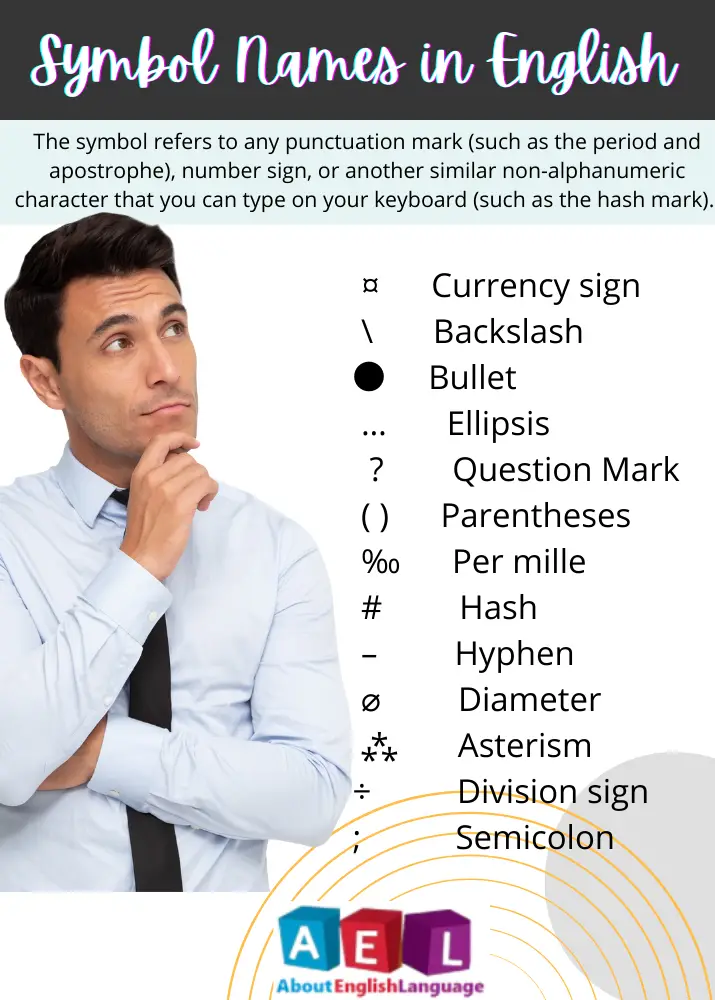Symbol Names in English
Symbol names in English, along with their phonetic pronunciations, Symbol refer to any punctuation mark (such as the period and apostrophe), number sign, or another similar non-alphanumeric character that you can type on your keyboard (such as the hash mark).
Symbol Names in English infographic

A symbol is a convention used to represent an idea, entity, or process in language or in other means of communication such as mathematics, music, or visual arts.
Symbols take the form of words, sounds, gestures, ideas, or visual images and convey intended meaning to other people.
For example;
If I wish to communicate that John Doe can be found at 111th St. and 6th Ave., I might say John Doe can be found at 111th St. and 6th Ave. This sentence makes use of concrete symbols (e.g., John Doe, 111th St).
Symbol Names in English List:
¤ Currency sign
\ Backslash
● Bullet
… Ellipsis
? Question Mark
( ) Parentheses
‰ Per mille
# Hash
– Hyphen
⌀ Diameter
⁂ Asterism
÷ Division sign
; Semicolon
¡ Inverted exclamation mark
× Multiplication sign
_ Underscore
℗ Sound recording
[ ] Square Bracket
℮ Estimated sign
№ Numeral sign
¶ Pilcrow
@ At the rate sign
« » Guillemet
! Exclamation Mark
™ Trademark symbol
^ Circumflex
. Full Stop
” “ Quotation Mark
§ Silcrow Servicemark symbol
/ Slash
⁀ Tie
% Percent
‘ Apostrophe
∴ Therefore sign
* Asterisk
> Greater Than
, Comma
® Registered trademark
≈ Almost equal to
& And
⟨ ⟩ Angle brackets
± Plus-minus sign
< Less than
: Colon
¿ Inverted question mark
© Copyright Symbol
{ } Curly Brackets
| Bar
= Equal
Detail of Symbol Names in English:
Full stop (.)
A full stop also known as an end stop or period has several uses in the English language, depending on its placement in the sentence.
It can be used to emphasize an important point, create flow and rhythm to your writing, or help readers easily identify where one idea ends and another begins.
Colon (:)
The colon (:) is one of the most misused punctuation marks in English writing. It has a variety of applications, including joining two distinct clauses into a single phrase and separating items in lists.
many people incorrectly use the colon to introduce an example or consequence following the first clause. This error often crops up in business writing and copywriting.
Semicolon (;)
Semi-colon (;), consists of two dots and, as the name suggests, it’s used to connect two clauses that are closely related to each other.
For example;
- My cat likes milk, but my dog likes milk too.
With the colon in place, you could revise it like this:
- My cat likes milk; my dog likes milk too.
Notice how the second sentence now refers to the specific information about your cat and your dog?
Quotation mark (“”)
Quotation marks are also called inverted commas, speech marks, or inverted commas in the UK and Australian English.
When we use them, we mean that the writer/speaker doesn’t agree with the speaker or writer that quoted what he said.
Comma (,)
The comma is one of the most underappreciated punctuation marks in the English language, with two primary uses and many others that are rarely used.
Commas are generally used to group sentence elements or indicate pauses within sentences, but their use varies from country to country and even from style guide to style guide.
Equal (=)
The equal sign (=) is one of the most commonly used mathematical symbols. The symbol has long been known to mean equal to, but it can be used in other ways as well.
Slash (/)
The slash (/) isn’t used that often in modern-day writing, and most people probably don’t even know what it stands for. In reality, the slash is quite useful, and understanding its functions can save you from making many common errors in word usage. Read more symbol names from wikipedia
